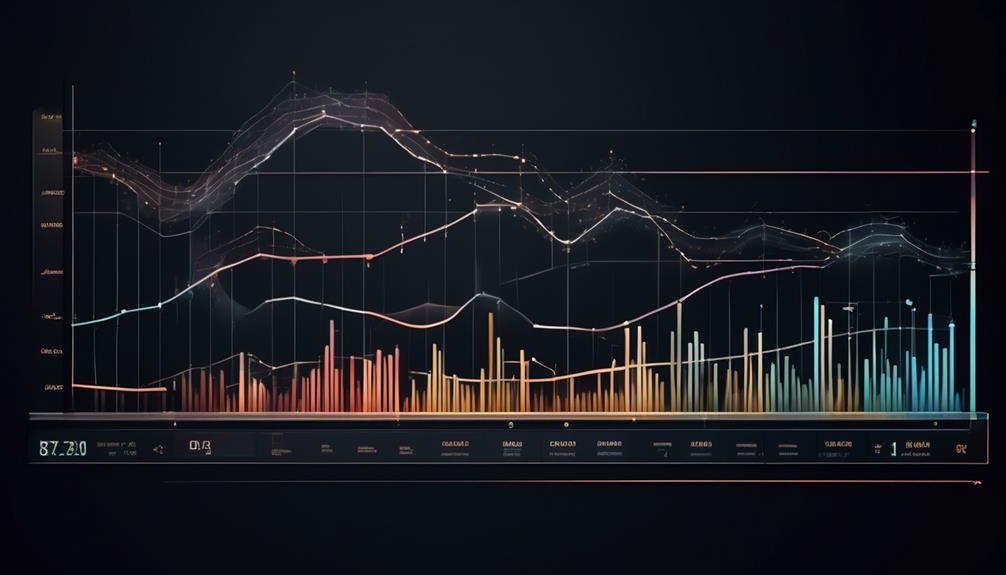Automated trend analysis helps you spot defects earlier by quickly identifying patterns and anomalies in large data sets. It continuously monitors data streams, alerting you to irregularities like spikes or drops before they cause major issues. This proactive approach allows you to address potential problems swiftly, reducing downtime and costs. With this technology, you gain a competitive edge, helping you make smarter decisions faster. Keep exploring to discover how it all works in detail.
Key Takeaways
- Automated trend analysis quickly identifies anomalies and deviations signaling potential defects before they impact quality.
- Real-time data monitoring enables early detection of irregularities, reducing the risk of system failures or product defects.
- Visual dashboards highlight emerging patterns, allowing for prompt intervention and corrective actions.
- Advanced algorithms learn from historical data to improve accuracy in spotting subtle defect indicators.
- Early defect detection through automation helps minimize costs, downtime, and enhances overall operational efficiency.

Automated trend analysis is revolutionizing how businesses interpret data by quickly identifying patterns and shifts without manual effort. Instead of pouring over spreadsheets or relying solely on intuition, you can leverage advanced tools that sift through vast amounts of information to highlight meaningful trends. This approach empowers you to respond faster to changes in your operations, customer behavior, or market conditions. One of the key components of this process is data visualization, which transforms complex data sets into clear, visual formats like graphs and dashboards. These visuals make it easier for you to grasp emerging patterns at a glance, ensuring you don’t miss critical developments. When you can see data trends visually, it becomes much simpler to spot deviations from the norm, such as sudden drops in sales or spikes in website traffic, that might indicate underlying issues or opportunities.
Anomaly detection plays a crucial role in automated trend analysis, helping you identify outliers that could signal potential problems or breakthroughs. For example, if your sensors detect a sudden temperature spike in a manufacturing process, anomaly detection algorithms can flag this immediately—long before it causes a defect or system failure. By catching these irregularities early, you can take corrective actions swiftly, minimizing downtime and reducing costs. Automated anomaly detection works hand-in-hand with data visualization, providing intuitive dashboards that highlight abnormal data points in real-time. This combination ensures you’re not only aware of what’s happening but can also interpret its significance quickly.
The beauty of automation in trend analysis lies in its speed and precision. Manual analysis can be slow, prone to human error, and often misses subtle shifts. Automated systems continuously monitor data streams, applying sophisticated algorithms to track minute changes that might escape your notice otherwise. Over time, these systems learn from historical data, improving their ability to detect meaningful anomalies and trends. As a result, you gain a competitive edge by identifying potential defects or market shifts early, before they escalate into serious issues. You’ll be able to adjust strategies, optimize processes, and maintain quality standards more effectively.
In essence, automated trend analysis transforms raw data into actionable insights through advanced data visualization and anomaly detection. It gives you the tools to stay ahead of problems, identify opportunities faster, and ensure your operations run smoothly. By embracing automation, you’re not just reacting to changes—you’re proactively managing your business’s success with confidence and precision.
Frequently Asked Questions
What Industries Benefit Most From Automated Trend Analysis?
You might wonder which industries benefit most from automated trend analysis. Manufacturing, for example, improves efficiency by quickly identifying production issues and preventing defects. The supply chain also gains, as it enables real-time tracking and forecasting, reducing delays and costs. By leveraging automated trend analysis, you can stay ahead of potential problems, streamline operations, and boost overall performance in these sectors, ensuring smoother, more reliable processes.
How Does Automated Trend Analysis Integrate With Existing Quality Systems?
You integrate automated trend analysis with your quality systems through real-time monitoring and seamless data integration. This allows you to continuously track product quality, quickly identify potential issues, and respond promptly. By connecting these processes, you guarantee your quality management becomes more proactive, reducing defects and improving overall efficiency. This integration streamlines workflows, enhances decision-making, and helps maintain high standards across your operations.
What Are the Common Challenges in Implementing Automated Trend Analysis?
Implementing automated trend analysis is like trying to tune a complex instrument; data integration can be tricky, and aligning diverse sources often slows progress. You might face issues with algorithm reliability, causing false alarms or missed defects. These challenges demand thorough planning and testing. To succeed, guarantee seamless data integration and continually refine algorithms, turning potential hurdles into opportunities for sharper, more reliable insights that improve overall quality management.
How Accurate Are Automated Trend Analysis Tools in Defect Detection?
You might wonder how accurate automated trend analysis tools are in defect detection. These tools rely on data accuracy, which directly impacts their effectiveness. While they can identify many issues early, false positives may occur, leading to unnecessary investigations. Overall, their accuracy improves with better data quality and tuning, but you should remain cautious, as no tool guarantees perfect detection. Regular validation helps maintain reliable results.
What Future Advancements Are Expected in Automated Trend Analysis Technology?
Think of the future of automated trend analysis as a crystal ball, revealing defects before they happen. You’ll see advances in machine learning that make detection smarter and more intuitive. Real-time analytics will become faster, providing instant insights and enabling proactive decisions. As technology evolves, you’ll benefit from more accurate, predictive tools that catch issues early, reducing downtime and costs—turning data into your most powerful ally.
Conclusion
By harnessing automated trend analysis, you become the lighthouse guiding your team through foggy waters, spotting defects before they reach the shore. It’s like having a vigilant eye watching over your ship, illuminating hidden dangers in the darkness. With this powerful tool, you turn data into a steady beacon, steering clear of costly surprises. Embrace automation, and let it be the steady flame that keeps your quality ship sailing smoothly, no matter how turbulent the seas.









